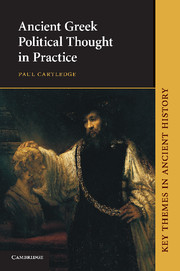Book contents
- Frontmatter
- Contents
- Preface
- Acknowledgements
- Timeline
- CHAPTERS AND NARRATIVES
- 1 Meaning in context: how to write a history of Greek political thought
- 2 The Greek invention of the polis, of politics and of the political
- Narrative I The prehistoric and protohistoric Greek world, c. 1300–750 BCE
- Narrative II The archaic Greek world, c. 750–500 BCE
- Narrative III The classical Greek world I, c. 500–400 BCE
- Narrative IV The classical Greek world II, c. 400–300 BCE
- Narrative V The Hellenistic Greek world, c. 300–30 BCE
- Narrative VI ‘Graecia capta’ (‘Greece conquered’), c. 146 BCE – CE 120
- APPENDIX I Selected texts and documents
- APPENDIX II The ‘Old Oligarch’: a close reading
- Bibliographical essay
- References
- Index
Narrative V - The Hellenistic Greek world, c. 300–30 BCE
Published online by Cambridge University Press: 05 June 2012
- Frontmatter
- Contents
- Preface
- Acknowledgements
- Timeline
- CHAPTERS AND NARRATIVES
- 1 Meaning in context: how to write a history of Greek political thought
- 2 The Greek invention of the polis, of politics and of the political
- Narrative I The prehistoric and protohistoric Greek world, c. 1300–750 BCE
- Narrative II The archaic Greek world, c. 750–500 BCE
- Narrative III The classical Greek world I, c. 500–400 BCE
- Narrative IV The classical Greek world II, c. 400–300 BCE
- Narrative V The Hellenistic Greek world, c. 300–30 BCE
- Narrative VI ‘Graecia capta’ (‘Greece conquered’), c. 146 BCE – CE 120
- APPENDIX I Selected texts and documents
- APPENDIX II The ‘Old Oligarch’: a close reading
- Bibliographical essay
- References
- Index
Summary
It is a moot point whether Alexander was the first ‘Hellenistic’ ruler, or the last great monarch of the ‘classical’ age. At any rate, Alexander's reign both spanned the transition between the two epochs and hugely hastened the full flowering of the post-classical dispensation. ‘Hellenistic’ as a term of art carries a number of different notions and applications: a fusion of some sort between Greek and – especially oriental – non-Greek cultures; a culture that was Greek-ish, in which, though the language of government and high culture was Greek, ‘native’ cultures not only survived but actually contributed something positive to the mix; and, perhaps above all, an epoch of transition, during which Greeks were less and less masters of their own destiny, and within which indeed they succumbed ultimately to the imperial power of Rome.
The wars of the Alexandrine succession lasted at least twenty-two years, until the Battle of Ipsus in 301 or even the Battle of Corupedium in 281. The resulting ‘Hellenistic’ political pattern saw a vastly enlarged Greek world that now embraced Egypt on the continent of Africa and stretched as far east in Asia as Pakistan, parcelled up into a relatively small number of territorial monarchies. The two most considerable of these, the Seleucids and the Ptolemies, were based respectively in Syria and in Egypt, and more or less inevitably doomed to clash repeatedly.
- Type
- Chapter
- Information
- Ancient Greek Political Thought in Practice , pp. 107 - 109Publisher: Cambridge University PressPrint publication year: 2009



